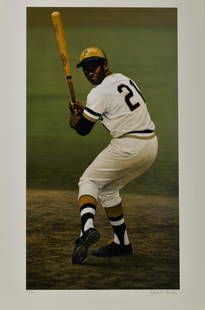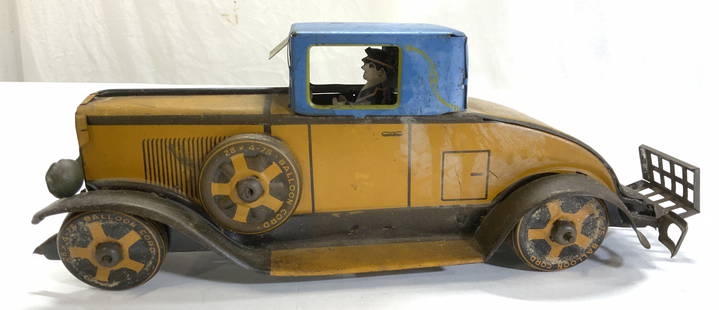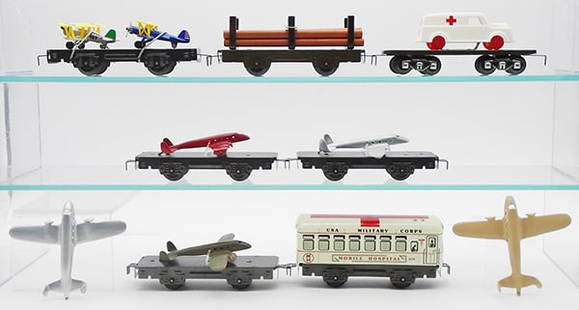
Lithograph by Roberto Burle Marx
Louis Marx & Company Sale History
View Price Results for Louis Marx & CompanyRelated Prints & Multiples
More Items from Louis Marx & Company
View MoreRecommended Art
View More








Item Details
Description
Lithograph by Roberto Burle Marx. 16.75" x 21.25". (From Wiki):"Roberto Burle Marx was born in São Paulo. He was the fourth son of Rebecca Cecília Burle, a member of the traditional Pernambuco family of French ancestry, Burle Dubeux,[1] and Wilhelm Marx, a German Jew born in Stuttgart and raised in Trier. The family moved to Rio de Janeiro in 1913.Burle Marx's first landscaping inspirations came while studying painting in Germany, where he often visited the Botanical Garden in Berlin and first learned about Brazil's native flora. Upon returning to Brazil in 1930, he began collecting plants in and around his home. He went to school at the National School of Fine Arts in Rio in 1930 where he focused on visual arts under Leo Putz and Candido Portinari. While in school he associated with several of Brazil's future leaders in architecture and botanists who continued to be of significant influence in his personal and professional life. One of these was his professor, Brazilian Modernism's Lucio Costa, the architect and planner who lived down the street from Burle.Itamaraty Palace, headquarters of the Ministry of External Relations in BrasíliaIn 1932, Burle Marx designed his first landscape for a private residence by the architects Lucio Costa and Gregori Warchavchik. This project, the Schwartz house was the beginning of a collaboration with Costa which was enriched later by Oscar Niemeyer who designed the Brazilian Pavilion at the New York World's Fair in 1939. Niemeyer also designed the Pampulha complex in 1942 for which Marx designed gardens. His first garden design was completed in 1933.[3] In 1937, Burle Marx gained international recognition and admiration for this abstract design of a roof garden for the Ministry of Education building. The design highlighted elements of tension and drama.In 1949 he acquired the Sítio de Santo Antonio da Bica, a 365,000m² estate in the Barra de Guaratiba neighborhood on the outskirts of Rio de Janeiro. Burle Marx began taking expeditions into the Brazilian rain forest with botanists, landscape architects, architects and other researchers to gather plant specimens. He learned to practice studying plants in situ from the botanist Henrique Lahmeyer de Mello Barreto and established his garden, nursery and tropical plant collection at Guaratiba. This property was donated to the Brazilian government in 1985 and became a national monument. Now called Sítio Roberto Burle Marx, under the direction of IPHAN-Instituto do Patrimônio Histórico e Artístico Nacional / Ministério da Cultura, it houses over 3,500 species of plants.[4] The house was rebuilt in a valley on the site of a garden house belonging to the original plantation estate.Roberto Burle Marx founded a landscape studio in 1955 and in the same year he founded a landscape company, called Burle Marx & Cia. Ltda. He opened an office in Caracas, Venezuela in 1956 and started working with architects Jose Tabacow and Haruyoshi Ono in 1968. Marx worked on commissions thorough out Brazil, Argentina, in Chile and many other South American countries, France, South Africa, Washington D.C. and Los Angeles. Additionally his artwork can be found displayed throughout the city of Rio de Janeiro "it is an open-air museum of works displaying his unmistakable style, one wholly his own" (Montero 2001 p. 29). Roberto Burle Marx's 62-year career ended when he died June 4, 1994 two months before his 85th birthday.He spent time in the Brazilian forests where he was able to study and explore. Burle Marx was one of the first Brazilians to speak out against deforestation.[5] This enabled him to add significantly to the botanical sciences, by discovering new rocks and plants for example. At least 50 plants bear his name.[4] Marx was also involved in efforts to protect and conserve the rain forest from the destructive commercial activities of deforestation for bananas and other crops and clear cutting of timber.Farmhouse and chapel gardens in Barra de Guaratiba where Burle Marx died in 1994Burle Marx's artistic style was avant-garde and modern. Much of his work has a sense of timelessness and perfection. He explored an anti-mimitec and skeptical aesthetic developed from modernism with a distinctly Brazilian style.[2] His designs were also influenced by cubism and abstractionism.[4] Another strong influence was Brazilian folk art.His aesthetics were often nature based, for example, never mixing flower colours, utilisation of big groups of the same specimen, using native plants and making a rocky field into a relaxing garden. He was very interested in each plant's character and what effect that has on the whole garden. He sought a depth in his designs by understanding how animals interacted with plants and how they bloomed, amongst other plant characteristics.[citation needed] Burle Marx had a great skill in utilising the sculptural form of plants. Burle Marx was mindful of the dynamic of walking through a garden. The sensation of mobility is an important element of experiencing his landscapes.[6] He also made clever use of enormous scale, lighting and reflection particularly in his use of water. Burle Marx was able to extend the architecture of a building into the garden. He preferred to work on public spaces because, in his words, they are able to provide dignity for the masses.Marx's work "can be summarized in four general design concepts—the use of native tropical vegetation as a structural element of design, the rupture of symmetrical patterns in the conception of open spaces, the colorful treatment of pavements, and the use of free forms in water features" (Vaccarino 2000, p. 17). This approach is exemplified by the Copacabana Beach promenade, where native sea breeze resistant trees and palms appear in groupings along Avenida Atlantica. These groupings punctuate Portuguese stone mosaics which form a giant abstract painting where no section along the promenade is the same. This "painting" is viewed from the balconies of hotels, and offers an ever-changing view for those driving along the beach. The mosaics continue the entire two and a half-mile distance of the beach. The water feature, in this case, is of course the ocean and beach, which is bordered by a 30-foot wide continuous scallop patterned mosaic walk (Eliovson 1991; Montero 2001). Copacabana Beach is "the most famous in Brazil" (Eliovson 1991 p. 103).Roberto Burle Marx has received the following prizes, diplomas of merit and honorary memberships: The landscape architecture prize at the 2nd International Exhibition of Architecture (1953), title of Knight of the Order of the Crown from Belgium (1959), Diploma d’Honneur in Paris (1959), the Santos Dumont Medal of the Brazilian Government (1963), the Fine Arts Medal of The American Institute of Architects in Washington (1965), doctor of the Royal College of Art, London (1982) and an honorary doctorate from the Queen of the Netherlands. The Missouri Botanical Garden awarded him the Greensfelder Award and the Kentucky Botanic Garden proclaimed October 14, 1985 in his honor (Eliovson 1991)."
Condition
Good condition overall.Good condition overall.David Killen Gallery does not guarantee works of art for authorship.We remove hundreds of paintings, watercolors and drawings out of NYC estates every year and we give out opinion as to their authenticity but at the end of the day they are sold as-is.Anyone unsure of the authenticity of any work of art sold in our auctions should consult an expert.
Buyer's Premium
- 25%
Lithograph by Roberto Burle Marx
Estimate $200 - $300
10 bidders are watching this item.
Shipping & Pickup Options
Item located in New York, NY, usSee Policy for Shipping
Payment
Accepts seamless payments through LiveAuctioneers

TOP





























![Marcia Marx Lithograph [Circus]: Marcia Marx (New York 1931 - 2005) signed lithograph. Signed 'Marcia Marx' in pencil lower right. Numbered '33/200' in pencil lower left. Measures about 16.5-in. x 23.25-in. image size, 19.875-in. x 2](https://p1.liveauctioneers.com/5755/154409/77936862_1_x.jpg?height=310&quality=70&version=1573094011)




















































